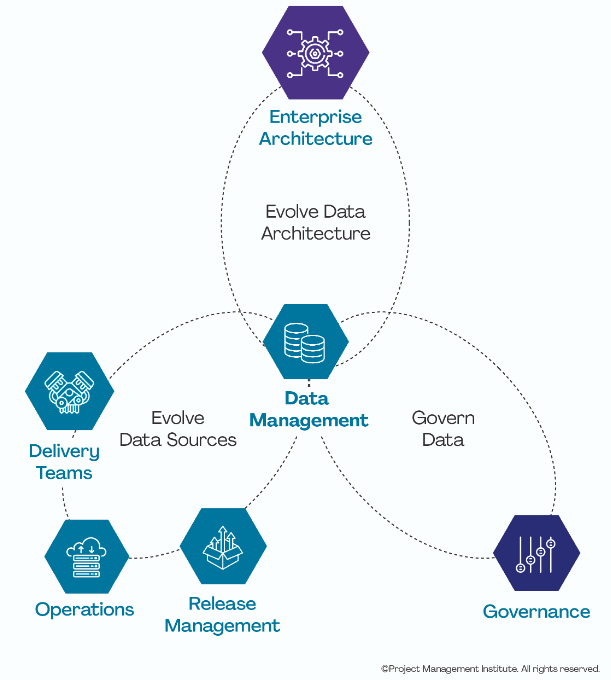Data management process is the development, execution, and sustenance of policies, practices, and procedures that define how an organization’s data is acquired, protected, defined, integrated, delivered, used, and destroyed.
Effective data management in every business is essential for ensuring the quality, security, and accessibility of data in research.
Your business could ensure data accuracy, streamline updates, and enhance decision-making capabilities by applying contact data quality services and creating a centralized database.
This process underscores the critical role of effective data management in leveraging data as a valuable asset for business and IT operations.
Effective data management process in business should involve steps like data validation, transformation, and storage, ensuring the integrity and usability of data.
The data validation includes identifying and correcting errors or marking them for deletion.
Transformation adjusts data to fit analytic needs, while storage must protect sensitive information, involving secure methods and de-identification to protect privacy.
Effective data management supports research validity, regulatory compliance documentation, and findings’ reproducibility.
Are you ready to explore the complex details of the data management process? Let’s learn more here.
But wait. For your note, a detailed explanation of data management in SAP software inspired this article.
Data Lifecycle Overview
A well-understood and executed data lifecycle enhances decision-making and boosts operational efficiency.
The lifecycle encompasses interrelated data-related activities. Let’s break down some of these activities.
- Initiate data collection: Kickstart the journey by gathering data through capturing, defining, and classifying crucial information. This foundational step sets the stage for the entire lifecycle.
- Prioritize data storage and maintenance: Focus on systematically organizing data to ensure its accuracy and completeness. Regular maintenance is vital in keeping data relevant and reliable.
- Transform data into insights: Process raw data to extract valuable information. Data truly begins to inform business decisions through insightful analysis at this stage.
- Enhance collaboration with data sharing: Share processed data across teams and departments. This fosters compliance with standards and regulations while promoting a collaborative work environment.
- Conclude with data deletion and archiving: Efficiently manage data by adhering to retention regulations and deleting outdated information. Archiving allows for the preservation of essential data for future reference.
These interconnected stages require careful planning and execution to safeguard data integrity, confidentiality, and availability.
A comprehensive understanding aids your businesses in optimizing data’s value throughout its lifecycle, driving informed decision-making and operational efficiency.
Data Governance
Data governance serves as the foundation of data management process, focusing on creating and implementing rules, policies, and standards to maintain data quality and ensure compliance.
Effective data governance policies and data security measures protect sensitive data, ensure its accuracy, and facilitate its availability for decision-making.
Compliance with regulatory requirements is a critical aspect of data governance, involving adherence to standards such as GDPR, CCPA, and HIPAA, among others.
A robust data governance framework helps organizations improve data access, achieve regulatory compliance, and enhance data quality, ultimately reducing data management costs and increasing stakeholder data access.
Data Collection Strategies
The appropriate data collection method is pivotal to meeting data needs and achieving business objectives. Various methods include manual entry, automation, and integration with existing systems.
The choice of method depends on factors like data volume, frequency of updates, and the level of accuracy required.
Automated collection methods, such as web scraping or API integration, offer efficiency and reliability for large-scale data needs.
Manual entry, though labor-intensive, may be necessary for capturing nuanced or unstructured data.
Integration strategies, leveraging existing software or platforms, ensure seamless data flow and consistency.
The effectiveness of data collection directly impacts subsequent stages of the data lifecycle, emphasizing the importance of strategic selection based on specific project requirements and business goals.
Data Storage Solutions
The evolution of data storage solutions reflects the growing complexity and volume of data managed by organizations.
Options like file storage, block storage, and object storage cater to different needs, with object storage being particularly suited for unstructured data like emails, videos, and images.
Top solutions in this category include Google Cloud Storage, Amazon Simple Storage Service (S3), and Azure Blob Storage.
For local solutions, direct-attached storage (DAS), such as hard disk drives and solid state drives, offers simplicity and speed but lacks the scalability and sharing capabilities of network-based solutions like network-attached storage (NAS) and storage area network (SAN).
Cloud storage, offering scalability and cost-effectiveness, is increasingly popular for its remote access and minimal maintenance requirements.
Hybrid cloud storage combines the best private and public clouds, allowing businesses to balance cost, performance, and security requirements.
Data Cleaning and Validation
Data cleaning and validation involve identifying and correcting errors or inconsistencies in data to improve its quality.
This process is essential for analytics, reporting, and decision-making, ensuring that the data used is accurate and reliable.
Techniques include verifying the data against known standards or rules, removing duplicates, and correcting format inconsistencies.
Regularly cleaning and validating data supports maintaining the overall health of an organization’s data assets, enhancing the reliability of business insights derived from the data.
Data Security Measures
Security measures like encryption, access controls, and regular audits are essential to safeguard sensitive information.
Encryption ensures that data is unreadable to unauthorized users, while access controls limit access to authorized personnel only.
Regular audits help identify potential security vulnerabilities and ensure compliance with data protection regulations.
These security protocols are critical in preventing data breaches and cyber threats, thus maintaining data confidentiality, integrity, and availability within an organization.
Metadata Management
Metadata provides essential context to data, making it easier to organize, discover, and utilize effectively.
Metadata management categorized data into various types, including technical, business, and process metadata, each serving different purposes within an organization.
Technical metadata, for instance, includes raw technical details like file type and size. In contrast, business metadata offers insights into data content such as ownership and subject matter.
Effective metadata management is pivotal, as it establishes a framework of processes, policies, and technologies for cataloging information assets throughout their life cycles, enhancing data understanding and usability across the organization.

Data Integration
Integrating data from diverse sources is crucial for providing a unified view of information enhancing decision-making capabilities.
This process involves consolidating data into a coherent structure, which is essential for organizations to understand their operations holistically and make informed decisions.
Effective data integration strategies ensure data is accurately merged from various sources, maintaining its integrity and relevance.
This fosters enhanced collaboration, streamlined processes, and improved organizational efficiency, ultimately leading to better business outcomes.
Data Retrieval and Analysis
Data retrieval and analysis are vital for transforming raw data into actionable insights. This involves utilizing various tools and techniques to access and examine data identifying patterns, trends, and anomalies.
Practical data analysis enables organizations to derive meaningful insights from their data, guiding strategic decisions and fostering informed decision-making.
The importance of this process lies in its ability to convert data into valuable information that can drive business growth, enhance operational efficiency, and foster innovation.
Data Archiving and Retention Policies
Establishing effective data archiving and retention policies ensures an organization’s compliance with legal, regulatory, and internal requirements.
These policies help define the duration for which data should be retained or archived, driven by business needs, legal obligations, and regulatory mandates.
Effective management of these policies contributes to enhanced data security, system optimization, and reduced IT costs, underscoring their significance beyond mere compliance.
For example, the General Data Protection Regulation (GDPR) highlights the importance of Storage Limitation, Minimisation, and Accuracy in shaping robust data retention policies.
These principles mandate that personal data should be retained only as necessary, only the minimal amount of data required should be collected, and the data maintained must be accurate and up-to-date.
Formulating a data retention policy requires a thorough understanding of various factors, including the specific types of data handled, the purposes for which data is retained, and the legal and regulatory environment in which the organization operates.
The absence of a well-defined data retention policy can lead to significant risks, including legal penalties, data breaches, and operational inefficiencies.
Conclusion
In light of everything we’ve discussed, we find ourselves in the vortex of data, where the distinction between valuable insights and mere noise is as fine as the line between success and stagnation.
Imagine if your business could speak to you, telling you exactly what your customers desire, predicting market trends, and whispering the secrets to operational efficiency. How good is it?
In this context, Nexalab offers a customized approach to your data management process challenges.
Nexalab is not just a solution but a digital enabler, transforming raw, unstructured data into actionable insights that propel businesses forward.
Yes, we don’t just manage your data; Nexalab weaves it into the fabric of your business strategy, ensuring that every byte serves a purpose, every dataset tells a story, and every insight contributes to your business’s growth.
So, with the competitive business landscape in Australia, collaboration with Nexalab isn’t merely an operational decision but an invitation to embark on a transformation.
This transformation will see data become your compass, guiding you through the complexities of the market landscape, uncovering the treasures hidden within your vaults, and charting a course to unprecedented success.
Yes, the future of your data management process is not an elusive technology in the futuristic IT landscape. It’s in your willingness to collaborate.




